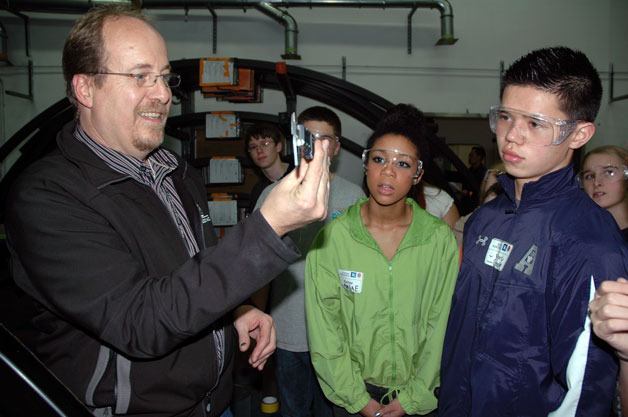MARYSVILLE — When Arlington High School students visited C&D Zodiac Aerospace in Marysville on Dec. 10, the Arlington students received not only lessons on the real-world applications of mathematics, but also a helping hand from the company’s Give and Grow foundation.
AHS Career and Technical Education Director Brett Sarver received a check for $1,500 from Cynthia Raynor, vice president and general manager of the company’s Marysville branch, to go toward the school’s Robotics Club, for whom Marysville C&D Zodiac Engineering Systems Specialist Stuart Weiler serves as a mentor.
For Sarver, this donation was a bonus to what he already saw as a generous contribution of time and insights from the company whose employees took his students on a tour of their Marysville facility to show them how essential mathematics are to their work.
“This started when a girl in one of our geometry classes said, ‘I’m never going to use this in my life,’” said Sarver, who reported that more students have requested to go on these math field trips since the first one to Arlington-based manufacturers AMT on Nov. 30. “We got connected with Stuart through the Marysville Arts and Technology High School’s FIRST Robotics team, who mentored our own, and Stuart helped us get in the door at C&D Zodiac. This partnership between the Marysville and Arlington communities has come full circle.”
C&D Zodiac and AMT each received 100 student visitors, along with supervising faculty members, and Sarver is already planning a third math field trip in the spring, either to a Marysville or to an Arlington company.
“We’ve had kids from Weston High School request this,” Sarver said. “They need to see why they need to learn this. It’s one thing to sit in a classroom and read about it, but actually seeing how that geometry is applied helps so much.”
Students at C&D Zodiac rotated through three subject areas, with Weiler and Computer Numerical Control Programmer Chris Holm explaining how their engineering computers run off precise geometry, while CNC Program Manager Gene Moomey and Quality Manager Bill Finch gave the students a firsthand look at the CNC and quality inspection processes, and Production Manager Gil Meeker showing them how the parts are made on the line.
“Geometry is everything in this job, I swear,” Weiler said. “The less a plane weighs, the less fuel it takes to fly it. You need to make parts that will all fit together within the dimensions of the plane, providing the maximum strength with the minimum weight and volume.”
Weiler and Holm agreed that even seemingly simple mathematic mistakes can cost a great deal of money, as when one machine was programmed with a datum of seven inches rather than negative-seven inches.
“A computer will do whatever you tell it to do,” Holm said. “If you tell it to drill holes in itself, it’ll do it.”
Moomey explained that the company’s five-axis routers calculate in three dimensions, by x, y and z coordinates, as well as two additional points, b and c, for the rotational axes. To demonstrate how narrow their engineering tolerances are, he used his calipers to measure the thickness of a human hair, donated by one of the students.
“Two thousandths of an inch,” Moomey said. “A typical tolerance for aerospace is 30 thousandths of an inch. Everything is controlled by math.”
Moomey likewise noted that while the ribs of an aircraft’s fuselage might appear to be consistent arcs, they come in more than a hundred different shapes, each specifically tailored to its section of the fuselage.
“They can’t be perfectly round, because they’d get crushed by pressure,” Moomey said. “So we give them more of an egg shape.”
Meeker listed his criteria for an entry-level employee at the company, emphasizing that the ability to learn is the most crucial skill he looks for.
“We have people who come in with no experience and people who have studied engineering for four to six years,” said Meeker, who echoed Moomey’s assurances to the female students that women are just as qualified to work in any position at their company as men. “We’re looking for at least high school graduates, because we need to know that you can be taught and you can complete a program of study.”







